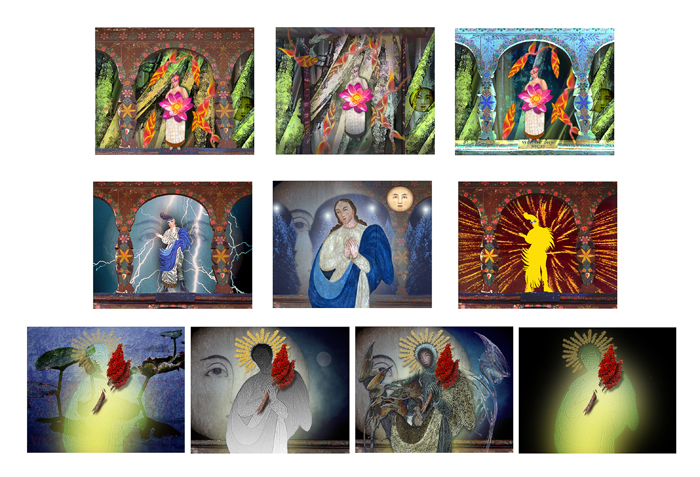Professor offers fresh perspective on Virgin Mary

LAWRENCE – As Christians are persecuted around the world, a University of Kansas assistant professor of film and media studies sees new importance in her unique representation of a centuries-old holy figure, the Virgin Mary.
Cathy Joritz’s artwork is based on an image of the Virgin Mary painted on an altar screen in an 18th century Spanish Colonial Mission church in New Mexico. Joritz digitally reimagined and recreated the Virgin Mary in various roles and scenarios: as a comforter to cancer survivors, female rebel, ethereal spirit and witness to dying animals.
“Being aware of the persecution of Christians and the demonizing of Christianity, I think it is more important than ever to present positive images of figures rooted in Christianity,” Joritz said. She pointed to Syria, Sudan and the more recent events of Boko Haram’s kidnapping of Nigerian schoolgirls.
Next month, Joritz will present her work for the first time at the Eighth International Conference of Iconographic Studies in Rijeka, Croatia. The conference will examine Christian iconography in modern and contemporary art.
Joritz’s fascination with the image of the Virgin Mary began years ago while driving through the American Southwest. She encountered the church of San Jose de Gracia in Las Trampas, a village in the mountain valley south of Taos, New Mexico.
Built between 1760 and 1776, the small church is home to an elaborate altar screen that was last repainted in the 1860s by Jose Gonzales. Joritz was attracted to the bright colors, animated poses and cartoon-like quality of the saints, all of whom were adorned with accessories. Though more than a 100 yeas old, the images came to life for Joritz.
“I could immediately imagine the holy figures moving and calling out to each other,” Joritz said.
She started animating several of the saints, but she found her focus drifting toward the altar screen’s central figure, the Virgin Mary. At first she added more earthly accessories to the Virgin Mary, then created a cartoon version of her and the variations grew from there.
Using digital software, Joritz changed Mary’s location from the decorative altar screen to placing her in the clouds, at the bedside of Joritz’s ailing mother, alongside previously photographed road kill and in nature. Other pieces feature the moon alongside Mary, a matriarchal symbol and part of the original painting. While most of Joritz’s Virgin Mary work is composed of digital collages, she also has produced several animated sequences including the figure.
Joritz said she keeps the Virgin Mary in the traditional role of witness, comforter and deity, but presents it in a way that is more alive and whimsical. Joritz hopes her images will offer a fresh perspective on a centuries-old figure, who otherwise is repeatedly presented in the same pose, dress and even facial expression.
“There is a lot of art that ridicules religion, but that isn’t my direction at all,” Joritz said. “I’m interested in creating images that further the idea of the Virgin Mary as an active, more accessible leader and yet still mysterious holy figure who can be seen as an entity to turn to, identify with, admire and worship at the same time.”
Another variation of Joritz’s work began when she digitally repainted a Polish iconographic image of the Virgin Mary and replaced Mary’s face with the photographed face of her own Polish mother.
“This allows women to see themselves in a more elevated, beautiful and spiritual role than just their material, everyday physical self," Joritz said. “My mom absolutely loved this, as did her neighbors, friends and even strangers. I think she saw herself in a beautiful way that she couldn’t have imagined.”